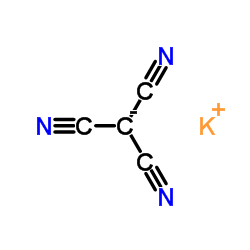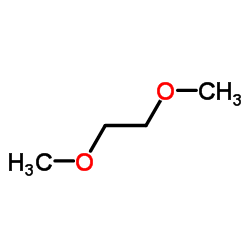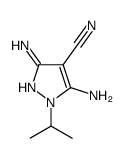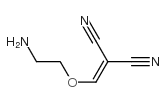三氰基甲烷化钾, ≥99%,Potassium Tricyanomethanide
产品编号:西域试剂-WR355969| CAS NO:34171-69-2| MDL NO:MFCD00058850| 分子式:C4KN3| 分子量:129.16
本网站销售的所有产品仅用于工业应用或者科学研究等非医疗目的,不可用于人类或动物的临床诊断或者治疗,非药用,非食用,
| 英文名称 | Potassium Tricyanomethanide |
|---|---|
| CAS编号 | 34171-69-2 |
| 产品沸点 | 178.9ºC at 760mmHg |
| 产品闪点 | 62ºC |
| 精确质量 | 128.972931 |
| PSA | 71.37000 |
| LogP | 0.26514 |
| 稳定性 | 如果遵照规格使用和储存则不会分解,未有已知危险反应 避免氧化物 |
| 储存条件 | 保持贮藏器密封、储存在阴凉、干燥的地方,确保工作间有良好的通风或排气装置 |
相关文档
化学品安全说明书(MSDS)
下载MSDS质检证书(COA)
相关产品
| 风险声明 (欧洲) | 23/24/25 |
|---|---|
| 安全声明 (欧洲) | 26-36/37/39 |
| 危险品运输编码 | UN 3276 |
| 包装等级 | II |
| 危险类别 | 6.1 |
| 海关编码 | 2926909090 |
|
Section 1: Product Identification Chemical Name:Potassium tricyanomethanide, min. 98% CAS Registry Number:34171-69-2 Formula:KC(CN)3 EINECS Number:none Chemical Family:metal cyano complex Synonym:none
Section 2: Composition and Information on Ingredients IngredientCAS NumberPercentACGIH (TWA)OSHA (PEL) Title compound34171-69-2100%no data5mg/m3 (as CN - skin) Section 3: Hazards Identification Emergency Overview:Toxic material by ingestion, inhalation and skin absorption. Primary Routes of Exposure:Ingestion, inhalation, skin, eyes Eye Contact:May cause moderate to severe irritation of the eyes Skin Contact:May cause slight to mild irritation of the skin, Skin adsorption may result in toxic effects. May be irritating to the nose, mucous membranes and respiratory tract. Decomposition products may include Inhalation: toxic hydrogen cyanide gas. Toxic if swallowed. High doses may cause vomiting, bloody diarrhea, twitching of facial muscles, convulsions, Ingestion: cyanosis, coma and death. Toxic by inhalation, in contact with skin and if swallowed. Cyanides may cause headache, dizziness, vomiting, Acute Health Affects: weak and irregular heart beat, unconsciousness, convulsions, coma and death. Chronic Health Affects:No information available on long-term chronic effects. NTP:No IARC:No OSHA:No SECTION 4: First Aid Measures Immediately flush the eyes with copious amounts of water for at least 10-15 minutes. A victim may need Eye Exposure: assistance in keeping their eye lids open. Get immediate medical attention. Wash the affected area immediately with water. Remove contaminated clothing if necessary. Seek medical Skin Exposure: assistance if irritation persists. Remove the victim to fresh air. Closely monitor the victim for signs of respiratory problems, such as difficulty Inhalation: in breathing, coughing, wheezing, or pain. In such cases seek immediate medical assistance. Seek medical attention immediately. Keep the victim calm. Give the victim water (only if conscious). Induce Ingestion: vomiting only if directed by medical personnel. SECTION 5: Fire Fighting Measures Flash Point:not applicable Autoignition Temperature:none Explosion Limits:none Extinguishing Medium:carbon dioxide, foam or dry powder If this product is involved in a fire, fire fighters should be equipped with a NIOSH approved positive pressure Special Fire Fighting Procedures: self- contained breathing apparatus and full protective clothing. Hazardous Combustion andIf involved in a fire this material may emit irritating fumes. Decomposion Products: Unusual Fire or Explosion Hazards: No unusual fire or explosion hazards. SECTION 6: Accidental Release Measures To avoid raising dust, small spills may be mixed with diatomaceous earth, sand, vermiculite or other suitable Spill and Leak Procedures: inert material and swept up. SECTION 7: Handling and Storage Handling and Storage:Handle and store the material under a dry inert atmosphere of nitrogen or argon. SECTION 8: Exposure Controls and Personal Protection Eye Protection:Always wear approved safety glasses when handling a chemical substance in the laboratory. Skin Protection:Wear protective clothing and gloves. Consult with glove manufacturer to determine the proper type of glove. Ventilation:Material may form a fine dust. If possible, handle the material in an efficient fume hood. If ventilation is not available a respirator should be worn. The use of respirators requires a Respirator Respirator: Protection Program to be in compliance with 29 CFR 1910.134. Ventilation:Material may form a fine dust. If possible, handle the material in an efficient fume hood. Additional Protection:No additional protection required. SECTION 9: Physical and Chemical Properties Color and Form:off-white to beige powder Molecular Weight:129.16 Melting Point:none Boiling Point:no data Vapor Pressure:not applicable Specific Gravity:no data Odor:none Solubility in Water:soluble SECTION 10: Stability and Reactivity Stability:air and moisture stable Hazardous Polymerization:no hazardous polymerization Conditions to Avoid:none Incompatibility:oxidizing agents and halogens Decomposition Products:carbon dioxide, carbon monoxide, nitrogen oxide, cyanides and potassium salts. SECTION 11: Toxicological Information RTECS Data:No information available in the RTECS files. Carcinogenic Effects:no data Mutagenic Effects:no data Tetratogenic Effects:no data SECTION 12: Ecological Information Ecological Information:No information available SECTION 13: Disposal Considerations Disposal:Dispose of according to local, state and federal regulations. SECTION 14: Transportation Shipping Name (CFR):Toxic solids, organic, N.O.S. Hazard Class (CFR):6.1 Additional Hazard Class (CFR):NA Packaging Group (CFR):II UN ID Number (CFR):UN# 2811 Shipping Name (IATA):Toxic solid, organic, N.O.S. Hazard Class (IATA):6.1 Additional Hazard Class (IATA):NA Packaging Group (IATA):II UN ID Number (IATA):UN# 2811 SECTION 15: Regulatory Information TSCA:Not listed in the TSCA inventory. SARA (Title 313):Title compound not listed. Second Ingredient:None SECTION 16 - ADDITIONAL INFORMATION N/A |
| 上游产品 1 | |
|---|---|
| 下游产品 6 | |








![2-[amino-(2-chloroanilino)methylidene]propanedinitrile结构式](/20230522/74904-80-6.png)






 浙公网安备 33010802013016号
浙公网安备 33010802013016号